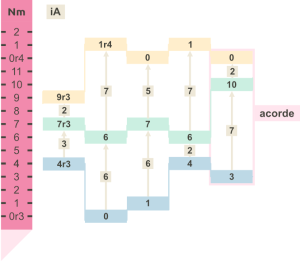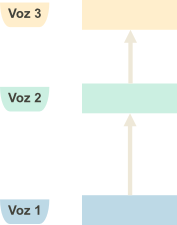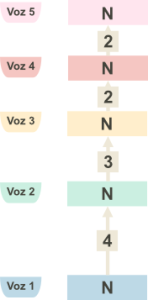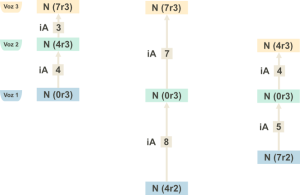Harmony and chords
The polyphony of 3 or more superimposed voices generates a new element to take into account: the chord. A chord is a vertical structure, formed by a set of 3 or more Notes sounding simultaneously and with vertical distances or iA between the Notes. It can be treated as a complex element, to create successions of chords. Harmony is the study of the vertical relationships established between voices:

In the superposition of voices, polyphony and harmony are actually two sides of the same coin: polyphony focuses on the melodies of each voice and the different simultaneous movements, and harmony focuses on the vertical relationship of the sounds sounding at the same time. The 2 are totally complementary, like Ying and Yang: although in the composition process we focus more on one of them, we must always take into account the other, since the essence of harmony is to create good melodies, and the essence of polyphony is to create good harmonies.
A chord is a vertical set of 3 or more notes that sound simultaneously creating a compact sound, resulting from the sum of individual notes. To express a chord we have two possibilities: as a set of Notes (they define the structure of the chord), or as a set of iAs (they define the sonority of the chord).
 |
 |
 |
| chord as a set of Notes | chord as a set of iA |
chord voices |
By arranging the Notes of the chord in a particular order, they are assigned a voice. We order the voices from low to high (v1, v2, v3…), and as we can see, between each voice there is a Harmonic interval (iA).
The vertical succession of iAs that occurs between the different Notes of the chord is called Harmonic structure (eA), for example eA (4 3 2 2 2):

The Harmonic structure (eA) of a chord does not imply that the Notes appear in that order; it only indicates its structure in its fundamental state from which we extract the collection of Notes of the chord. As we can specify the exact order and position of the Notes in the collection in different ways, the resulting succession of iAs between the Notes is different in each case. Let’s see an example with the collection of notes of the chord (0, 4, 7):

In all 3 cases the chord remains the same and therefore they all have a common sonority. Notice how the iAs change between voices depending on how we order the Notes and their registers.

